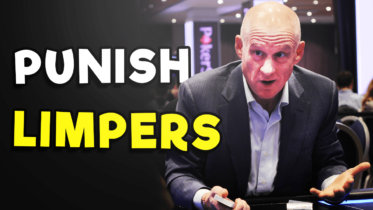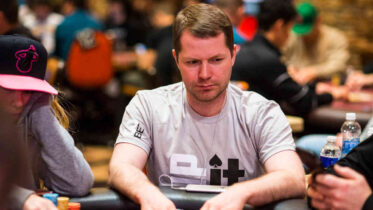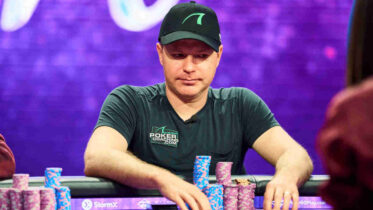I’ve taught hundreds of people to play poker tournaments and cash games in live settings. There’s a fascinating tendency that all poker newbies share: they want to “continue” in the hand. So the question they always ask is, “How much do I have to put in?”
“Nothing. That’s the beauty of this game – you can fold and not put any more chips in.”
“But I want to play.”
No matter how much I try to impress a “raise or fold” strategy, the urge to simply “continue” is overwhelming. That is, folding means you don’t get to play, and raising is scary. So calling – “limping” – seems like a great choice.
This tendency persists with most poker players – including those who have been playing the game for a long time. Even players who have studied some and “know” better, routinely fall victim to the siren call of, “Put in the minimum amount of money required to see a flop, and hope the dealer picks me.”
So when you play live poker, particularly at low-stakes, you will see tons of limping. Since we know that’s a mistake, there must be a way we can capitalize on that mistake, and make money. Here are three great ways to punish people who limp in preflop.
#1: Don’t make the same mistake of limping weak hands
The most important way to punish limpers: “Don’t make the same mistake they do.” That is, it is a -EV play to limp in middle position with T♣7♣. So if your opponents are doing that, they are losing money. Because poker is a zero-sum game, that money has to go somewhere, and some of it will go to you. However, if you limp with T♣7♣, then you are making the identical mistake, and you’ve given back the profit that you were going to make from their mistake.
Why is limping with T♣7♣, Q♦4♦ and similar hands a -EV play?
- There are long odds against these hands hitting any serious value. It’s easy to remember the times they smashed the flop, but you quickly forget the many multiples of times they whiffed completely, or – worse – gave you just enough to continue one more street and throw good money after bad.
- Hitting your miracle two-pair or trips isn’t enough to win a big pot – somebody has to make a second-best hand. This isn’t video poker.
- The kinds of hands you want to pay you off when you smash a flop are likely to be raising preflop, and denying you the cheap flop you were hoping for. It’s great to have T♣7♣ when the flop comes A♥-T♠-7♦ and somebody has A♠K♣, but that hand is almost always raising preflop, and punishing you for trying to sneak into a flop for cheap.
Note that your opponents are also trying to sneak in with weak hands hoping to smash a flop. Mimicking their strategy means that nobody, except the house, wins.
So simply don’t copy the mistake that your opponents make by limping weak hands, and you will immediately profit from those mistakes.

Make the best preflop decisions with Jonathan Little’s Push/Fold Charts!
#2: Squeeze litters of limpers with raises
When the opportunity arises, you can print money by “squeezing” litters of limpers. Suppose you’re in a $1/3 game, three people limp in front of you, and you find K♥9♥ in the cutoff. It’s not a particularly great hand, but it’s good enough for your purposes here. Since there wasn’t a raise in front of you, it’s likely that nobody has a very strong hand. They’re trying to sneak into a flop for cheap, violating Rule #1 above. When you put in a big raise, those limpers are faced with a dilemma. They can either:
- Fold, and forfeit the investment they’ve made in the pot and whatever equity they have, or
- Call, taking a weak hand to the flop out of position against a strong range.
As you can see, neither option is very appealing to your opponents, which makes it extremely appealing to you.
Now, a litter of limpers forming ahead of you is not, ipso facto, a license to raise. If you were to raise every time the right conditions arise, your raising range would not be strong enough. While Plan A is, indeed, to win the pot without a flop, you will have to resort to Plan B (playing a flop) frequently enough that your hand must have robust equity in that situation.
Very specifically, you should be squeezing a linear range – raising with the strongest hands, and not including any bluffing hands.
Squeezing from late position
For live games, if I’m acting in late position, my formula is 3-4 times the big blind, plus one more for every limper in front of me. So, let’s say you’re playing $2/$5. There are two limpers in front of you, and you find 5♠5♦ in the hijack seat. This is a great squeeze opportunity. 3 x $5 = $15, + (2 x $5) = $25. If you wanted to make it $30 or even $35, I wouldn’t object. The real danger of a big opening raise is that if you get 3-bet, you will frequently have to fold your hand and forfeit your original raise. For instance, if you were to squeeze to $30 with 5♠5♦, and get 3-bet to $100, you would have to fold. However, if 3-bets are rare in your game as they are in most low-stakes games, then there’s no penalty for the large open. Now, you almost always get the button and occasionally win the pot right there.
I say “occasionally” you’ll win the pot immediately. While that might be the most desirable outcome, it’s rare for the entire litter to fold en masse. Regardless, two positive things have already happened:
- Whichever limpers fold leave their chips behind in the pot. Those chips now subsidize the dollar equity of all remaining players in the pot. Because you often have the best hand, you collect the lion’s share of those extra dollars.
- If you have constructed your squeezing range well, then you have a hand that will perform well after the flop, and are often last to act. That means that you’ll over-realize your equity going forward.
So whether you win the pot immediately or not, you have punished the limpers for their mistakes. One outcome might be better than the other, but they are both good.
Squeezing from out of position
If you’re out of position, then the hammer needs to be that much bigger. Let’s say you’re playing $2/3, there are three limps, the small blind completes, and you find A♦J♣ in the big blind. It can be tempting to say, “Show me a flop, and hope I hit top pair.” But it will be miserable to navigate the rest of the hand, even if you flop well – five-way flops are a mess.
So let’s raise. Make it $25. Yes, that’s 8x the big blind. And now that I think about it, $30 or $35 is better.
Again, it’s great if everybody folds, but that’s infrequent. Still, we usually thin the field some, and share the folded equity with the others still remaining in the pot. If we pick a strong linear range with which to raise, we will profit handsomely, even out of position.
Honestly, it’s taken a while for me to come around to this thinking. For years, when given the chance, I would gladly tap the table with A♦J♣ in the big blind, and hope to hit a flop. My private coach finally got tired of this, and said, “Look, put in a big raise. If you get called, but only continue when you flop top pair or better, you’ll still be showing a profit. The only awful outcome is if somebody limp-reraises you. And then, you’ve usually run into KK+ and are happy to fold.” He was right, and I’m making more money because of it.
I know these raise sizes seem insane, but we would love to end the hand immediately. If raising doesn’t force everyone out of the hand, we want to extract maximum preflop value from the weaker hands that have limped in. People at the table will look at you askance – “You know this is a $2/3 game, right?” Furthermore, many of them will be aware of what you’re doing, but no one person is in a position to do anything about it. What are they going to do – call $35 with T♣7♣ and hope to out-flop you?
Sometimes you’ll hear comments about your big raise as everybody folds back around. Such comments are completely inappropriate (nobody should be discussing what’s happening during the hand) but ignore them. It’s like the weather – they can complain about it, but they can’t really do anything about it.

Read one of the highest regarded articles on the PokerCoaching.com blog: The Bankroll Bible
#3: Don’t pay other poker players off when they get there
The third, and final technique: do not let flop lotto players cash their tickets for full value. It is a fact of poker that sometimes T♣7♣ will smash a flop. On occasion, it will happen when one of your opponents holds that hand, and you hold a strong second-best hand.
Consider our example above, where I said, “It’s great to have T♣7♣ when the flop comes A♥– T♠- 7♦, and somebody has A♠K♣.” If you are the person with A♠K♣ , then you are in for some bad news. If you have raised big preflop, and they call, you have already punished them. The second half of that punishment is to not pay them off.
At some point, often on the turn, they will spring the trap and raise (or check/raise) you. Now you foil their plan by folding. You will have many better hands (AA, TT, AT) that will likely win a stack from the T♣7♣ – do not reward their sloppy limping by giving them a stack when they hit a miracle flop and you have a single pair.
I know what you’re going to ask: “But what if they are bluffing?” Well, they may be bluffing, and in fact, this might be the very time that your opponent check/raised with a draw of some sort.
If so, good for them. Just because they could be bluffing doesn’t mean that it’s correct to call. They have to be bluffing sufficiently often that you have the correct price to call. They just don’t bluff that frequently. A huge percentage of the time, they’re going to show you T♣7♣ or an equally silly hand that is better than yours. Now you’ve turned their bad play into a good one by paying them off huge when their flop lotto ticket hits.
Punish limpers by folding, then by raising, then by folding
While folding doesn’t seem like a profitable play, it certainly is one when the alternative choice is -EV. This is particularly true when your opponents are taking the alternative choice. Every time you fold T♣7♣, Q♦4♦, or any similar trashy hand, visualize your opponents limping along with it, and profit dollars flowing from them to you. See how easy that was?
After you’ve developed the passive income stream of folding hands that your opponents limp in with, you can advance to actively profiting from those mistakes by squeezing when the time is right.
Finally, when you’ve done your job by raising your strong hands, and squeezing when you should preflop, do not pay off people when they announce, via their bets, that the dealer picked them to flop a premium-beater.
It’s a deadly one-two-three profit punch.




